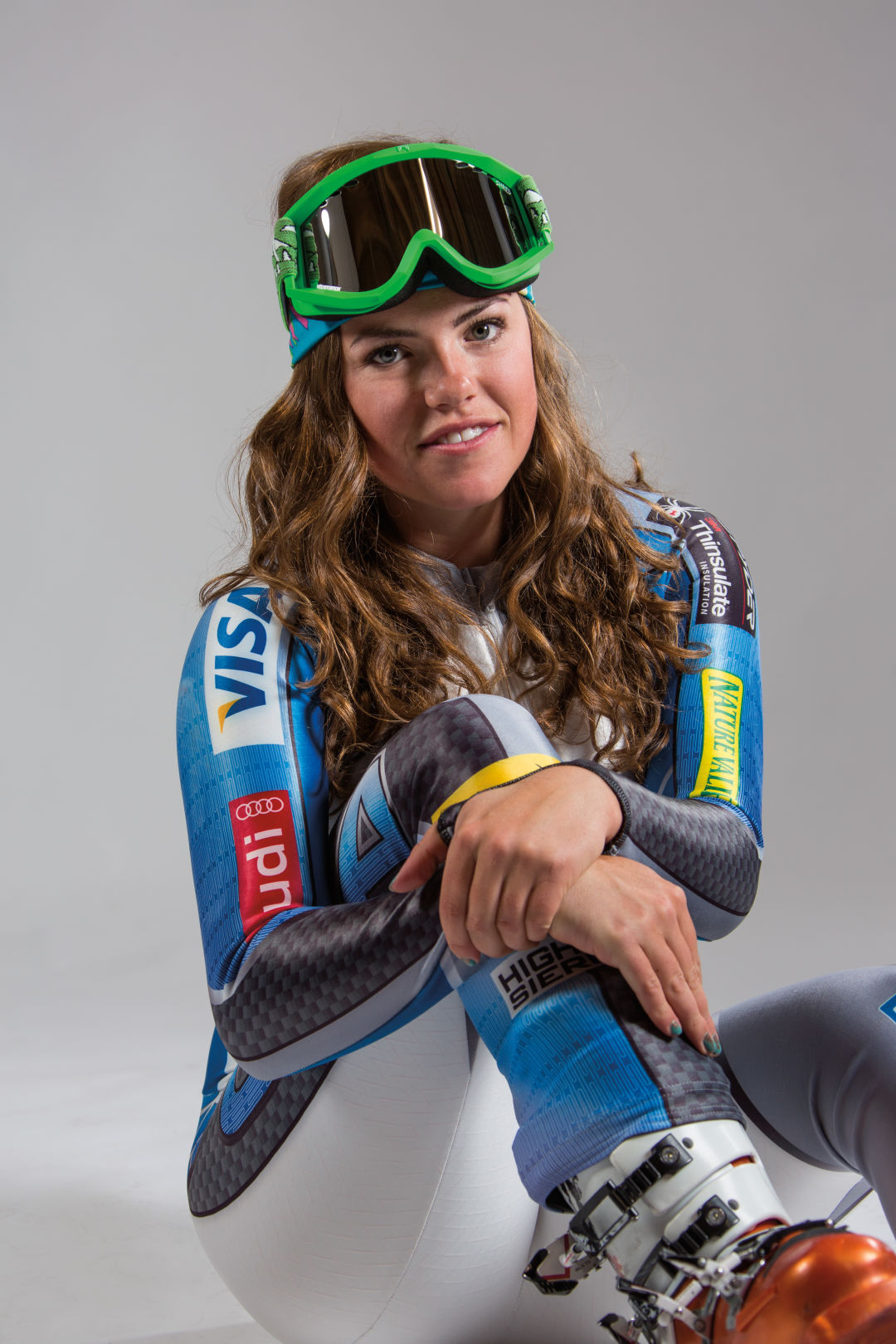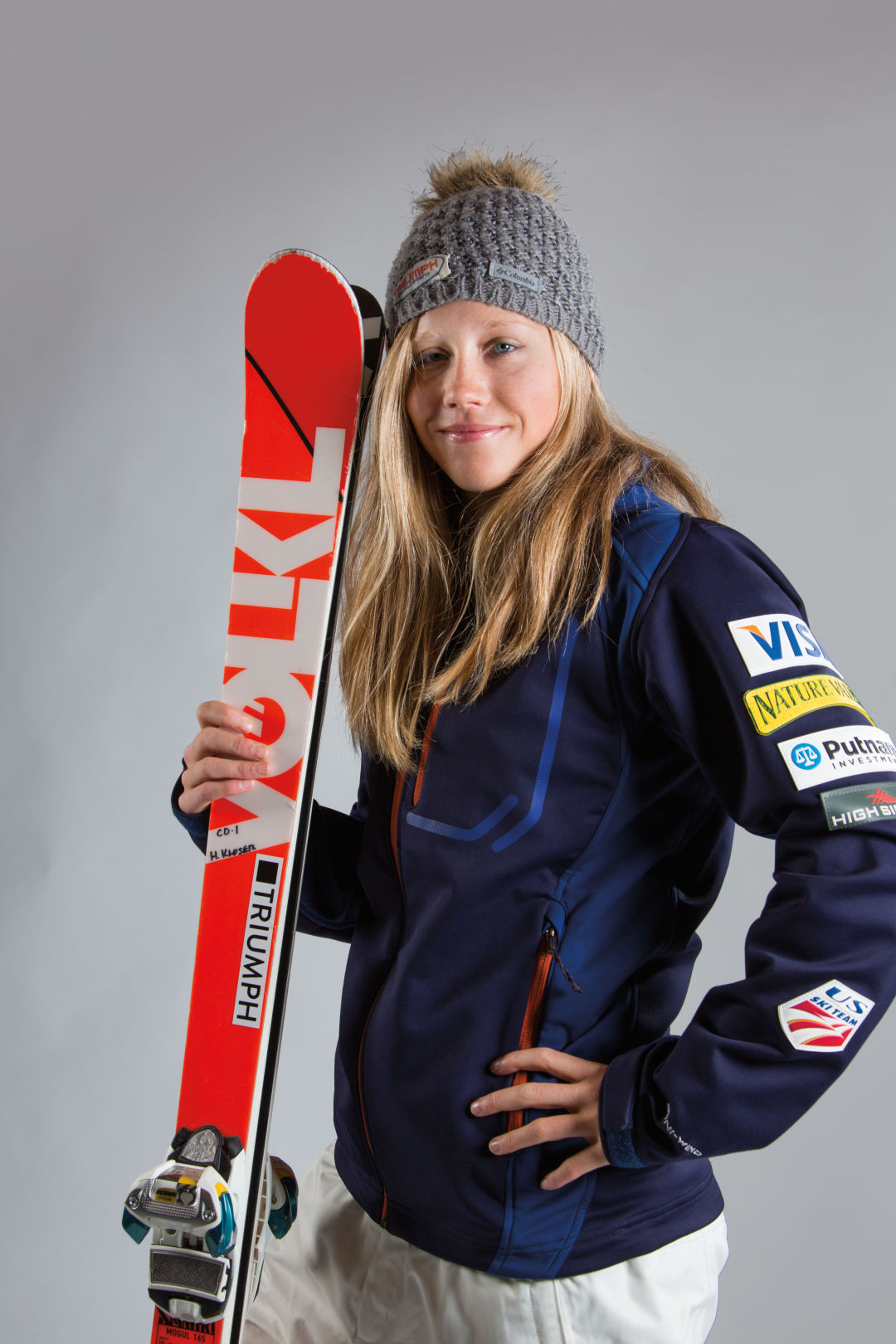Olympics or Bust

KATHERINE ERWIN: Age: 19 Hometown: Vail US Ski Team squad: Alpine D Team Years on team: 3 CAREER HIGHLIGHTS: 2011: First place (giant slalom, super-G), J2 Nationals 2012: First place (super-G), Nor-Am Cup 2012–13: 10 podium finishes, Nor-Am Cup, FIS races
Image: Brent Bingham
"I probably won’t go to the Olympics this year,” says Katharine Irwin. It’s not that Irwin lacks interest, or motivation, or talent. In truth, this 19-year-old Vail native would give anything—and has been giving almost everything—to claim a spot on the US Olympic team. All summer, when most skiers have moved on to other pursuits, Irwin logged six-hour strength-training sessions designed to supercharge her performance as a slalom and downhill racer. But it wasn’t enough to land her an all-expenses-paid trip to the Winter Games—not yet, anyway.
“There are seven girls on the US Team who have podiumed on the World Cup and only four spots for the Olympics,” she continues. Those coveted slots will presumably be apportioned out among America’s best-ever female skier, Lindsey Vonn; her fellow Ski and Snowboard Club protégé, and world slalom champion, Mikaela Shiffrin; three-time Olympic medalist Julia Mancuso; and A-teamers Stacey Cook, Alice McKennis, Leanne Smith, and Laurenne Ross, all of whom have landed in the “big money” on the World Cup (where the prize purse for a top-three finish ranges from about $10,000 to $45,000).
That leaves Irwin—who just realized her first international race victory last winter on one of the World Cup’s premier feeder circuits, the Nor-Am Cup—out of contention. “I would definitely like to go,” she says wistfully. “But my main goal this season is to break into the World Cup.”
Until then, Irwin will shell out tens of thousands rather than win them. Like the Vail Valley’s other unsung Olympic hopefuls who toil in obscurity in the lower echelons of the US Ski Team, including Abby Ghent and Heidi Kloser, Irwin must fork over her own cash to keep racing. For all but the very highest-ranked racers, skiing costs a small fortune.
Annual travel expenses for members of the US Ski Team’s developmental squad average $23,500. The Vail Valley Foundation helps Irwin a little, but the bulk of the cost falls to the skier and her parents. “Camps, travel, bags, food, lodging,” Irwin tallies. “We pay as we play.”
Yet “play” is a misnomer. A racer’s life consists of early mornings, extreme cold, dangerous slopes, missed proms, and deferred college degrees. What keeps Irwin going is the rush of adrenaline she gets every time she flies over snow. That, and the hope of one day winning big—Olympic big.
Irwin, like Ghent and Kloser, first clipped boots to bindings when she was barely 2 and started competing at 6, after joining Ski and Snowboard Club Vail. As the youngest of the three, Irwin hasn’t notched as many big results as Ghent or Kloser, but by the time she was 14 she was already competing at a national level. Two years later, she won giant slalom and super-G titles. Those results qualified her for the US Ski Team, when the real commitment began.
Relocating first to Mount Hood then to the US Ski Team’s Center of Excellence in Park City, Irwin’s first summers on the team consisted of training six days a week from 7:30 a.m. to 2:30 p.m. The drill: arrive and eat breakfast, warm up, play a vigorous game like volleyball or basketball, use the foam roller on tight muscles, stretch, power-lift, take a half-hour break, then return for a cardio session on the treadmill or spin bike followed by a run or mountain bike ride outside, a hamstring workout, stretching, and lunch. The schedule remained much the same once she relocated, late this summer, to Ski Club Vail’s headquarters. Add September snow training in South America, and by the time race season begins, Irwin barely remembers what day it is.
“On a race day, we get to the mountain four hours before the race and do a run in the parking lot when it’s pitch black out,” she says. “Then we stretch, do some movement stuff, get on snow, take a few warm-up runs, inspect the course, come inside, and prepare for a race run. After the race we do cool-down runs and go for a fifteen-minute walk.”
Getting injured is an occupational hazard in any sport, but when you fly around gates at speeds ranging from 25 to 80 mph, injuries can be serious enough to sideline a promising career. During her first Europa Cup event (the World Cup’s top-rated feeder circuit) Irwin crashed and tore her left calf muscle, a mishap that took her out of competition for about a month. And sometimes even goofing around exacts its toll: a year ago, Irwin tore all of the ligaments in her ankle playing disc golf. “This will be my first season back, and hopefully I will have a full preseason and then move into the full season,” she says. “You can’t think about that when you’re in the start gate. You just have to look and think about moving forward.”
The ultimate goal of all this time and work? The Olympics, of course. Irwin realizes she’s a long shot to make it to the Games in Sochi this February, but she’s only 19; there’s always 2018.
“Right now it’s pretty much all I know,” she says. “Plus, skiing down a hill at 80 mph is pretty fun. The adrenaline makes me want to go back. I can’t imagine not doing it.”

Abby Ghent
Image: Brent Bingham
Rockin’ the Slopes
Abby Ghent loves speed. The 21-year-old, who excels at downhill, giant slalom, and super-G, made her first World Cup starts last season. Although she didn’t land in the points (thirtieth or better), she finished third in the season standings in downhill and overall on the Nor-Am Cup circuit. After a little sponsor help (Rossignol, Slytech, and Swix donate equipment), she now pays $15,000 per year to maintain her US Ski Team berth.
“It’s been dropping ever since I joined the team, so that’s good,” says Ghent, a four-year team member who, for the first time this season, is trying to do a little fundraising. She registered for rallyme.com, a site that specializes in raising money online for sports teams and athletes.
A member of the US Ski Team’s unofficial and up-and-coming acoustic rock band—harmonizing with Alpine A Teamers Laurenne Ross, Julia Mancuso, and Stacey Cook, all of whom played their first official concert at last season’s Mammoth Invitational—Ghent loves singing and country music.
“I don’t usually take it out in public too much, but I really enjoy singing,” Ghent says. “That is something I’d want to pursue if I weren’t a ski racer.”
But Ghent doesn’t lament the things she’s missed due to racing. After a lot of thought about what her life would be like as a typical teenager and young adult, all she can say is that if she weren’t a ski racer, she might have tried to be a better student—even though she finished high school (Vail Ski & Snowboard Academy, the same school Irwin and Kloser attended) with a near-4.0 GPA.
“I feel like I could have done more—taken higher classes, learned a little more. But I’m sure I’ll get all that at college,” Ghent says. “There are definitely moments when we see our old friends from public school and wonder what that would have been like. Yeah, I would have been a way better student, but all the drama and stuff—I get plenty of that on the road.”
Although the life of a lower-ranked skier might seem lackluster—not to mention expensive—compared to that of other professional athletes, the intense focus (and yes, danger) holds an allure that is addictive for Ghent. “I think it’s just the mystery of what could happen that keeps me with it,” she says. “I kind of like to imagine and dream and see what I actually do achieve.”

Heidi Kloser
Image: Brent Bingham
Bumpin’ It Up a Notch
If you’ve spent any time at all in the Vail Valley, you’ll have heard the name Kloser. Former moguls skier Mike Kloser is a multiple-world-champion adventure racer who’s won Eco Challenges and National Winter Triathlons. He is revered locally as one of the greatest athletes the valley has ever produced, and in fact, the whole family comprises famously bionic human beings—including daughter Heidi, 21, a moguls specialist on the US Ski Team’s Freestyle B squad.
Heidi Kloser is one acorn that hasn’t fallen far from the tree. After finishing in the top fifteen four times during her debut year on the World Cup in 2010, she was named FIS World Cup Moguls Rookie of the Year. Last year, she landed her first World Cup podium and three more top tens. Yet she, too, must pay to maintain her spot on the team. Except unlike Irwin and Ghent, Kloser’s sponsors (Triumph Development, Vail and Beaver Creek, Völkl, Marker, and Oakley) pick up most of the $10,000 bill.
“It is difficult for me to pay, and I would not be able to do it without their help,” Kloser says. “I try to buy plane tickets and whatever I can out of my personal account, because that $10,000 will not cover it all.”
But for her, the thrills are worth that sizable tab. “I get to hit jumps, do sick airs, and ski as fast as I can through a mogul field while remaining in control,” says Kloser, who loves the fast, technical aspects of mogul skiing. And she’s willing to put in the training to do it. “I love working hard,” she explains. “I like lifting weights, bouncing on the trampoline, water ramping, and riding my bike, and I get to do all of those things to train for mogul skiing.”
It cost her an injury, when she tweaked her knee training at Vail in February 2012. She went into a back flip and her ski—and knee along with it—twisted in the soft snow. However, like Katharine Irwin, Kloser is uncowed by the memory of the injury, and she managed to earn a couple of her top ten finishes following the incident.
“Sure, it is risky,” she admits. “But that’s what makes it fun, and it makes me strive to be stronger so I can hopefully be more resistant if I make a mistake. I don’t mind that it essentially takes up my whole life. If I didn’t have mogul skiing to occupy my life, I would just have to find something else that did.”
Of the three local young women on the US Ski Team’s development squad, Kloser stands the best chance to go to this season’s Winter Games, and she knows it.
“I have been dreaming about going to the Olympics since I was a little girl,” she says. “I really want to go. Standing on top of the podium would truly be a dream come true. But right now I need to focus on my skiing, and I hope that the results will come from there.”






































